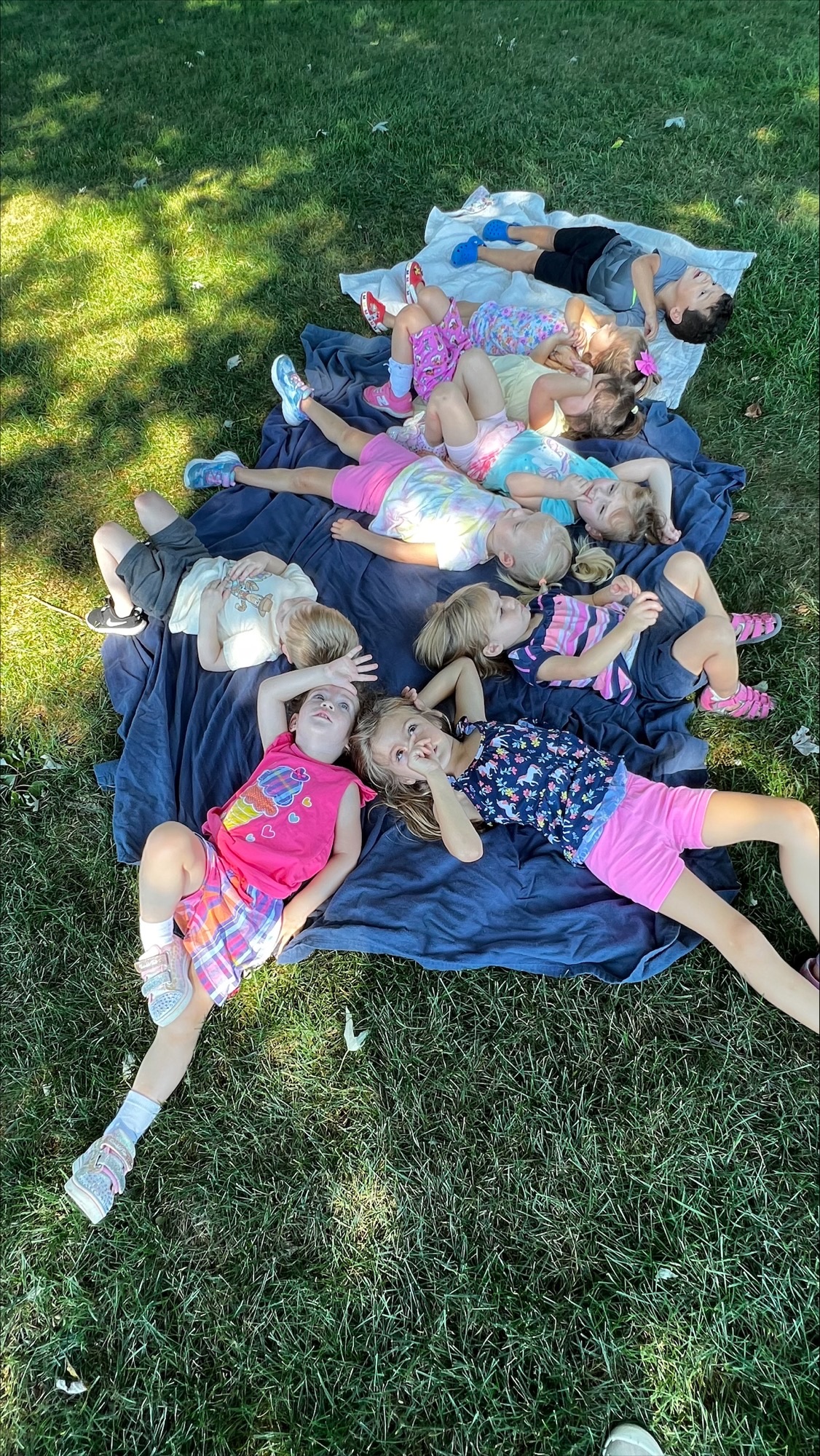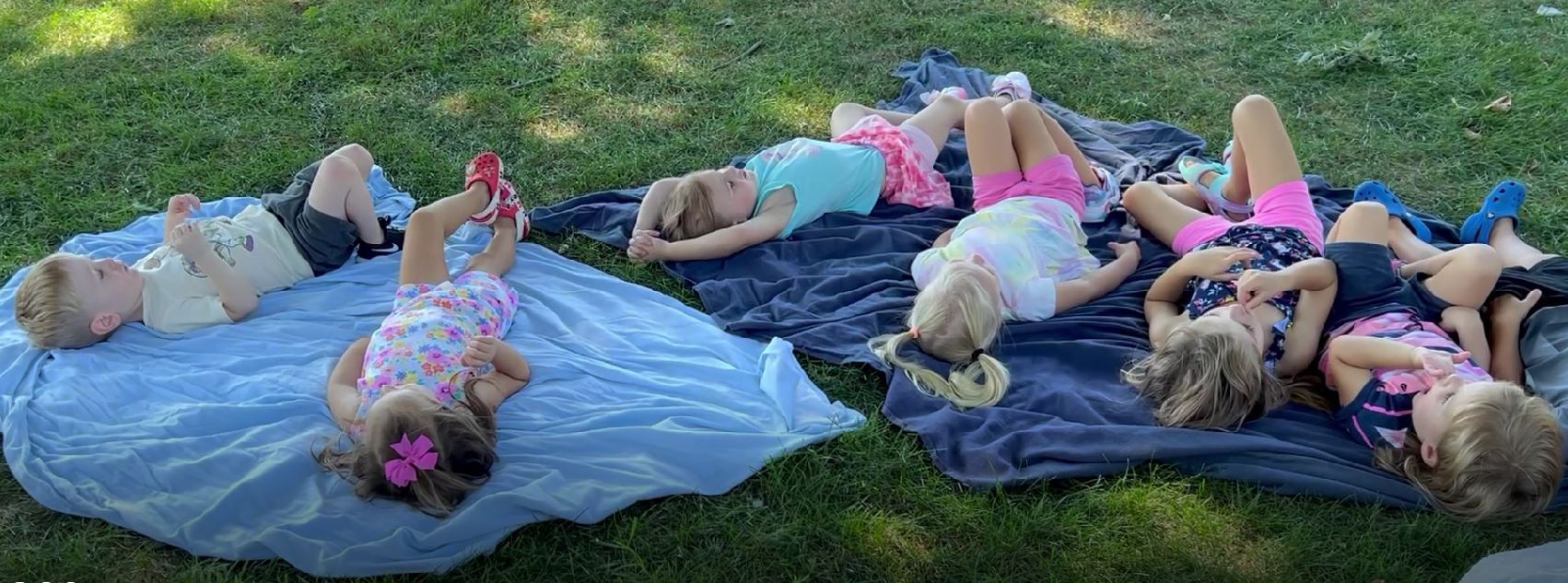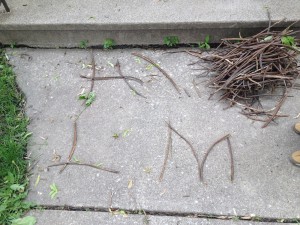When planning activities for mixed-age groups, there are a number of considerations to make. Keeping all children safe, engaged, and supported takes a lot of practice and skill! Thankfully, there are a number of ways to provide individualized experiences within one activity to meet the needs of all children.
- Safety first: Modify the environment so infants and toddlers cannot access choking hazards that older children may be using. This might involve baby gates or having the older children work on an inaccessible tabletop while infants and toddlers work on a lower surface.
- Plan for complexity: if you are planning a painting activity, have different materials available to accommodate and build on different skill sets. Infants and toddlers can fingerpaint, while preschoolers and school-age children can use brushes of different sizes and experiment with purposeful color mixing.
- Allow for “helpers”: preschoolers and school age children can feel pride and competence when given tasks to help adults– especially to distinguish themselves from the “babies.” Giving older children the responsibility of helping to maintain their own materials (washing paint brushes, putting away blocks, wiping up spills) is beneficial for their development and will help them feel ownership over the space and materials.
- Make a “yes space”: There are going to be times that the older children need more attention or are engaging in an activity too complicated for toddlers. Having a smaller space where the younger children cannot get into the older children’s activities becomes important at these times. While it must be in a space that can be supervised at the same time as the older children, it should be fully child-proofed and stocked with items that will keep the younger children’s interest.
With all of the challenges working with mixed age groups can present, there are so many benefits for the younger children, who get to spend their days with role models, and the older children who get to practice being compassionate and caring friends.
While there are many places to buy curriculum for early childhood programs, the most beneficial learning experiences for children are planned by the people who know them and their abilities and interests.
Starting with children’s interests, and then seeing the skills that can be developed within those interests, is at the heart of a lesson plan. If the most popular toys among the children is the train set, how can that expand through activities that will support their learning and development across domains?
Counting the trains out loud and comparing the length of two or more trains will introduce children to foundational math skills of comparison and number sense.
Adding books about trains to your library and finding some train songs (or adding trains to songs they already know– “The Wheels on the Train”, anyone?) will expose children to new vocabulary and give them opportunities to deepen their understanding of what a train is. Don’t limit yourself to fiction, either– many young children are absolutely fascinated by books with real pictures that explain how the mechanics work.
Painting with train wheels can be a thrill for young children! Running the trains through paint and over paper allows them to see how a wheel moves and understand the cause and effect of paint drying out and no longer transferring to paper, then refreshing the paint and painting smooth lines again.
Of course, trains are only one common interest young children have. These same principles apply, whether they’re exploring spiders, puppets, or mermaids. Noticing what children are learning and using academic skills as the tools that they are to help advance childrens’ ideas and understanding will prepare them to use these skills as they grow.
Academic skills are tools that we want children to have and be able to use. Just like a quizzing a child on how to use a hammer, offering worksheets, and reading books won’t teach that child how to use a hammer, teaching academic skills without opportunities to hold, manipulate, and experiment with them won’t offer children competence and expertise.
Reflection Questions
What common interests are you seeing in the children you work with? What themes are recurring?
What resources can you use to determine the academic skills children can acquire through their play and through interactions with adults?
What can a child learn from a fight? A lot, with the right opportunities.
A dispute with a peer can teach a child about how to voice their own needs, how to weigh the needs of another, and how to compromise and problem-solve with others.
In the Japanese practice of Mimamoru (literally, “watch and protect”), early childhood practitioners are trained to intervene minimally and later than many American early childhood educators would expect, while still closely observing children’s fights. The principle behind this is that while the adult’s role is to protect the children, children need the experience of navigating social complexity to build their social skills. A child who hits another and is then sent away from the activity learns that the adult nearby doesn’t want them to hit but does not learn how to get their needs met. When that same adult stop in, checks on the child who was hit, and helps both children verbalize their wants and needs, both children have the opportunity to understand each other and find a solution.
Perhaps the more difficult situation here is one where the attacks aren’t physical, but emotional. Relational aggression (e.g. “You’re not my friend!” or “You can’t come to my birthday party!”) can be more difficult to intervene in, and harder to spot. This also tends to peak in late preschool and early elementary years as children refine their definition of friendships and understand what it means to be a friend, as well as the power that comes from being included or excluding others.
In either act of aggression, how can the educator offer a learning opportunity instead of simply managing or shutting down the behavior? People are born with the desire to connect, and emotional resilience, as well as a guiding moral voice. What needs to be scaffolded are the skills to advocate for oneself and listen to and hypothesize about others’ perspectives.
First, look at the purpose of adult interventions: no one wants the children to be hurt, physically or emotionally. But in the same way that learning to walk comes with a few tumbles, learning to be a friend and participant in a community comes with its own missteps. If children cannot learn from each other and us when they’re small, they won’t have the experience to navigate social relationships as they become more complex.
This is the platform on which larger concepts of restorative justice are built; instead of punishing the person who harmed another, we work to ensure that the person who was hurt is comforted, and the person who did the hurting has the resources to avoid doing it again.
Questions for your reflection:
- What was your first reaction when you thought about waiting to intervene?
- What are your current intervention strategies when children are fighting?
- How could you integrate a “pause” before intervening?
- What else could you do to support children in learning conflict mediation?
Provide children with a large sheet of butcher paper and small trays or plates with paint to explore dipping and making marks with recycled materials such as toilet paper or paper towel tubes, containers of various shapes and sizes, materials with different textures, etc. This could be an activity that is available over several days that children can experiment with in a variety of ways.
Goal: Children will work collaboratively, use fine motor skills, and explore making marks with paint using a variety of recyclable materials.
Looking at the sky is a simple and relaxing activity that fosters observation and creativity skills. It can change your perspective of the world as you have to explore a broader view. Children can see different animals or flying objects, some we may have missed if we don’t look up. They can also observe cloud formation and shape. Develop their creativity in describing what clouds look like and the stories the clouds are telling us. Next time you are outside, encourage children to look up and explore the sky. You can invite them to this activity by simply laying down a blanket or, if available, providing binoculars!
Preschool children love to help. You can ask children to create videos or even a series of photos to explain how to do something or even steps or guidelines for a routine activity like hand washing, as this example from a provider illustrates:
Children might like to share ideas about things like how to get ready to go play outside, how to clean up after a meal, what to do with your things when you come in, or any number of other things. You can create a slide show with pictures or post a child-created video to a private YouTube channel to share with families. This appropriate use of technology that features the children in your care is sure to be an exciting activity.
Goal: Involve children in communicating information using technology.
Give children a spray bottle with water or a small container of water with a brush so they can wet a window. Have a variety of foam shapes that children can stick to the window to create scenes or patterns. You can buy pre-cut shapes or you can cut out your own shapes from fun foam sheets, both of which are relatively inexpensive at the craft store.
Goal: Children will enjoy sensory play with water while creating patterns or scenes with shapes.

Ask children to gather sticks (if outside) or provide Popsicle sticks or straws (if indoors). Then have children create shapes or letters using the sticks. Talk about the number of sticks you need to create specific shapes or letters and encourage the children to talk together about what they made.
Goal: Children will use sticks to create shapes and letters





